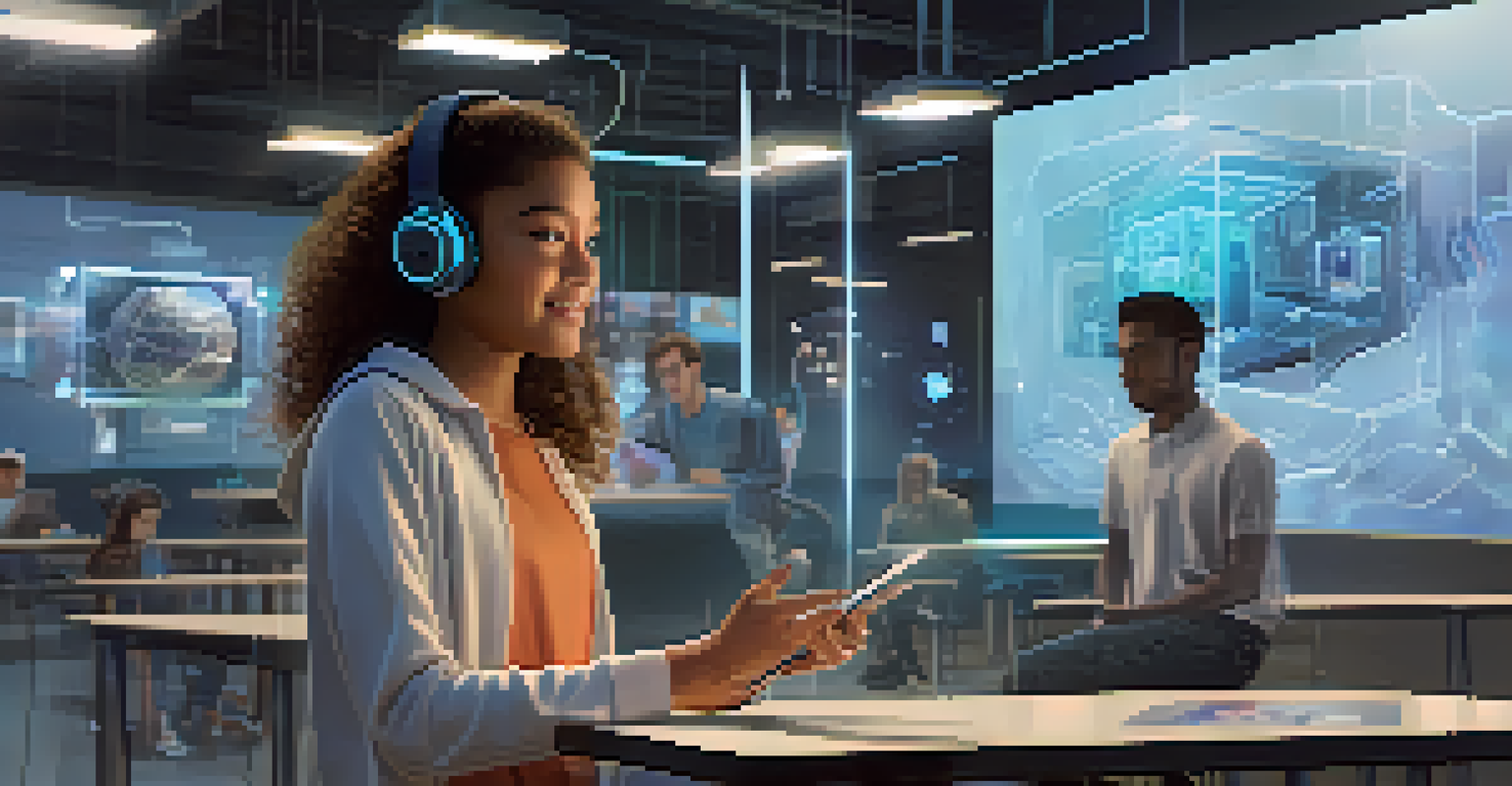Utilizing Chatbots to Support Blended Learning Strategies

Understanding Blended Learning and Its Benefits
Blended learning combines traditional face-to-face instruction with online learning, creating a flexible educational experience. This approach allows students to learn at their own pace while still benefiting from direct interaction with instructors. One of the key advantages of blended learning is its ability to cater to different learning styles, making education more inclusive and engaging.
Blended learning is an innovative approach that combines the best of both worlds—traditional teaching and digital tools—to create a more engaging learning experience.
For instance, a student who thrives on visual content can access videos and infographics online, while another who prefers hands-on learning can participate in live discussions. This blend not only enhances the learning experience but also encourages active participation. As a result, blended learning environments can lead to improved academic performance and higher retention rates.
In today's fast-paced world, the need for adaptable learning solutions is more critical than ever. By embracing blended learning, educational institutions can meet the diverse needs of their students and prepare them for real-world challenges. This is where chatbots come into play, offering innovative ways to support and enhance this educational model.
What Are Chatbots and How Do They Work?
Chatbots are AI-driven tools designed to simulate conversation with users, providing instant responses and assistance. They can be programmed to answer frequently asked questions, deliver course content, or guide students through their learning pathways. By using natural language processing, chatbots can understand and respond to students in a way that feels both intuitive and engaging.

For example, a student struggling with a math problem could ask a chatbot for help, receiving step-by-step guidance in real-time. This immediate support can alleviate frustration and encourage students to seek help without hesitation. Furthermore, chatbots are available 24/7, meaning learners can access assistance whenever they need it, regardless of time zone.
Blended Learning Enhances Engagement
Blended learning combines traditional and online instruction, catering to various learning styles and fostering active participation.
This flexibility is particularly beneficial in blended learning environments, where students may have varying schedules. By incorporating chatbots, educators can ensure that students receive consistent support, enhancing their overall learning experience and promoting greater engagement.
Enhancing Student Engagement Through Chatbots
One of the significant challenges in blended learning is maintaining student engagement, especially during online components. Chatbots can play a crucial role in keeping learners motivated by providing interactive and personalized experiences. For instance, they can send reminders about upcoming assignments, quizzes, or live sessions, helping students stay on track.
Chatbots have the potential to transform education by providing personalized learning experiences and instant support to students, making learning more accessible and efficient.
Moreover, chatbots can facilitate discussions and group work by creating virtual study groups or forums. By encouraging collaboration, students can benefit from diverse perspectives and peer support, which can enhance their overall understanding of the material. This interaction fosters a sense of community, even in an online setting.
In addition, chatbots can gather feedback from students regarding their learning experience. This information can help educators adjust their teaching strategies to better meet student needs, ultimately leading to a more engaging and effective blended learning environment.
Providing Personalized Learning Experiences with Chatbots
Personalization is a key factor in effective education, and chatbots excel at delivering tailored learning experiences. By analyzing student data, chatbots can recommend resources or activities that align with individual learning styles and progress. For example, a student struggling with a specific topic can receive targeted exercises to help reinforce their understanding.
This tailored approach not only boosts student confidence but also encourages self-directed learning. When students feel that their unique needs are being addressed, they are more likely to take ownership of their education and actively engage in the learning process. Chatbots can also adapt their responses based on a student’s previous interactions, creating a more customized experience over time.
Chatbots Provide Instant Support
Chatbots offer 24/7 assistance, helping students with immediate responses to questions and facilitating personalized learning experiences.
Furthermore, chatbots can facilitate adaptive assessments, adjusting the difficulty of questions based on a student’s performance. This level of personalization ensures that learners are continually challenged without feeling overwhelmed, leading to a more satisfying and effective educational journey.
The Role of Chatbots in Administrative Support
Beyond direct student engagement, chatbots can significantly streamline administrative tasks within blended learning environments. They can handle routine inquiries about course schedules, enrollment processes, and grading policies, freeing up educators to focus on teaching. This efficiency is crucial in ensuring that students receive timely information and support.
For example, a chatbot can assist a student in navigating the registration process, providing step-by-step guidance and answering any questions that arise along the way. This not only enhances the student experience but also reduces the administrative burden on staff. By automating these processes, institutions can ensure that resources are allocated more effectively.
In addition, chatbots can help gather data on student interactions and performance, providing valuable insights for administrators. This information can inform decision-making and help institutions refine their blended learning strategies, ultimately leading to improved outcomes for students and educators alike.
Overcoming Challenges in Implementing Chatbots
While the benefits of chatbots are clear, implementing them in blended learning environments can pose challenges. One major hurdle is ensuring that the chatbot is equipped with accurate and relevant information. Institutions must invest time and resources into training the chatbot to provide reliable responses, as any misinformation can lead to confusion and frustration among students.
Another challenge lies in ensuring that chatbots can seamlessly integrate with existing learning management systems and platforms. Compatibility issues can hinder the effectiveness of chatbots, making it essential to choose solutions that are user-friendly and adaptable. Institutions should also consider the user experience, ensuring that the chatbot interface is intuitive and easily navigable.
Future of Chatbots in Education
Advancements in AI and machine learning will enhance chatbot capabilities, making them even more integral to adaptive and personalized learning.
Finally, institutions must be proactive in addressing any concerns regarding data privacy and security. As chatbots collect and process student information, it’s crucial to establish robust protocols to protect sensitive data. By addressing these challenges head-on, institutions can maximize the potential of chatbots in their blended learning strategies.
Future Trends: The Evolution of Chatbots in Education
As technology continues to advance, the role of chatbots in education is likely to expand and evolve. Future trends may include the integration of artificial intelligence and machine learning, allowing chatbots to provide even more personalized and adaptive learning experiences. Imagine a chatbot that not only answers questions but also anticipates student needs based on their learning patterns.
Additionally, the incorporation of voice recognition technology could enable students to interact with chatbots through speech, making the experience even more natural and accessible. This could be particularly beneficial for students with disabilities or those who prefer auditory learning. As these technologies mature, the potential applications for chatbots in education will grow exponentially.

Ultimately, the ongoing evolution of chatbots presents exciting opportunities for enhancing blended learning strategies. By staying ahead of these trends, educational institutions can create more engaging, efficient, and effective learning environments that cater to the diverse needs of their students.